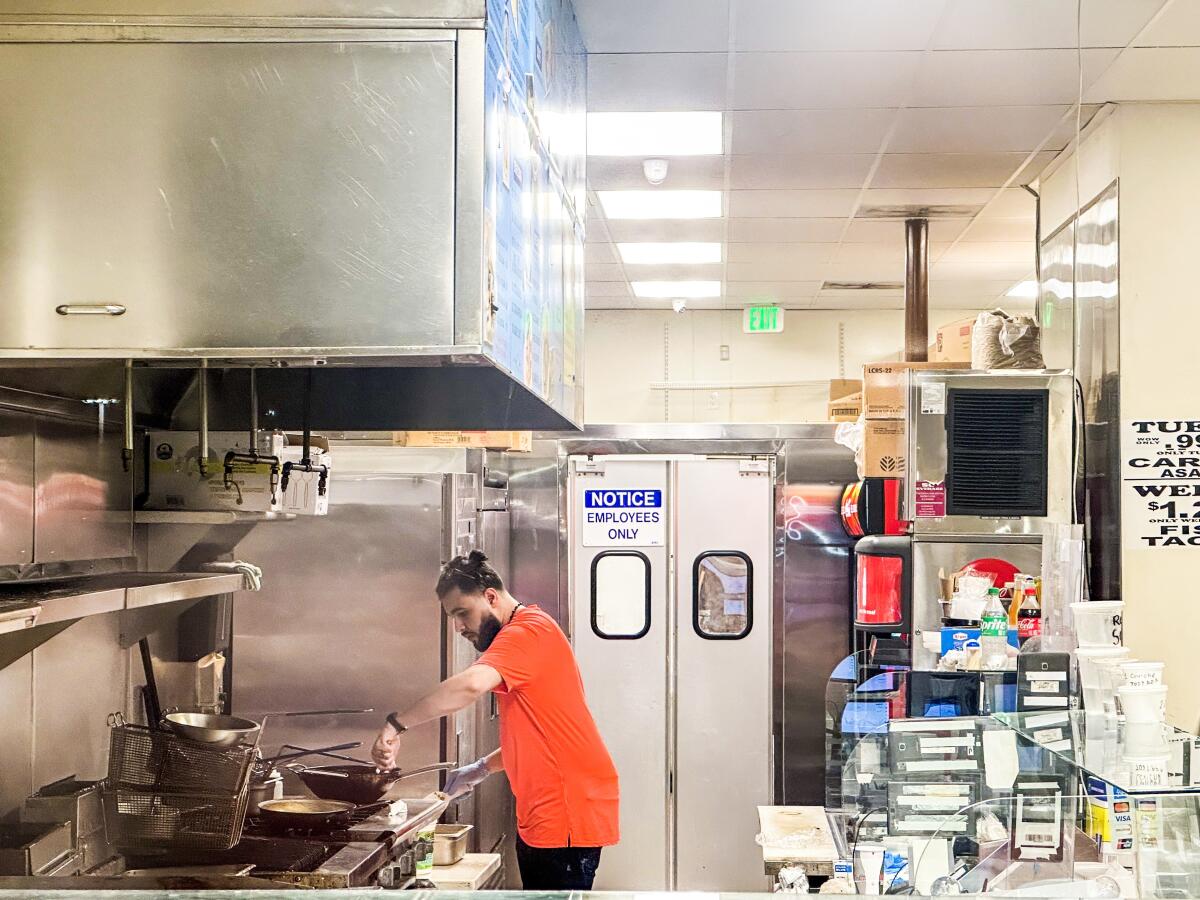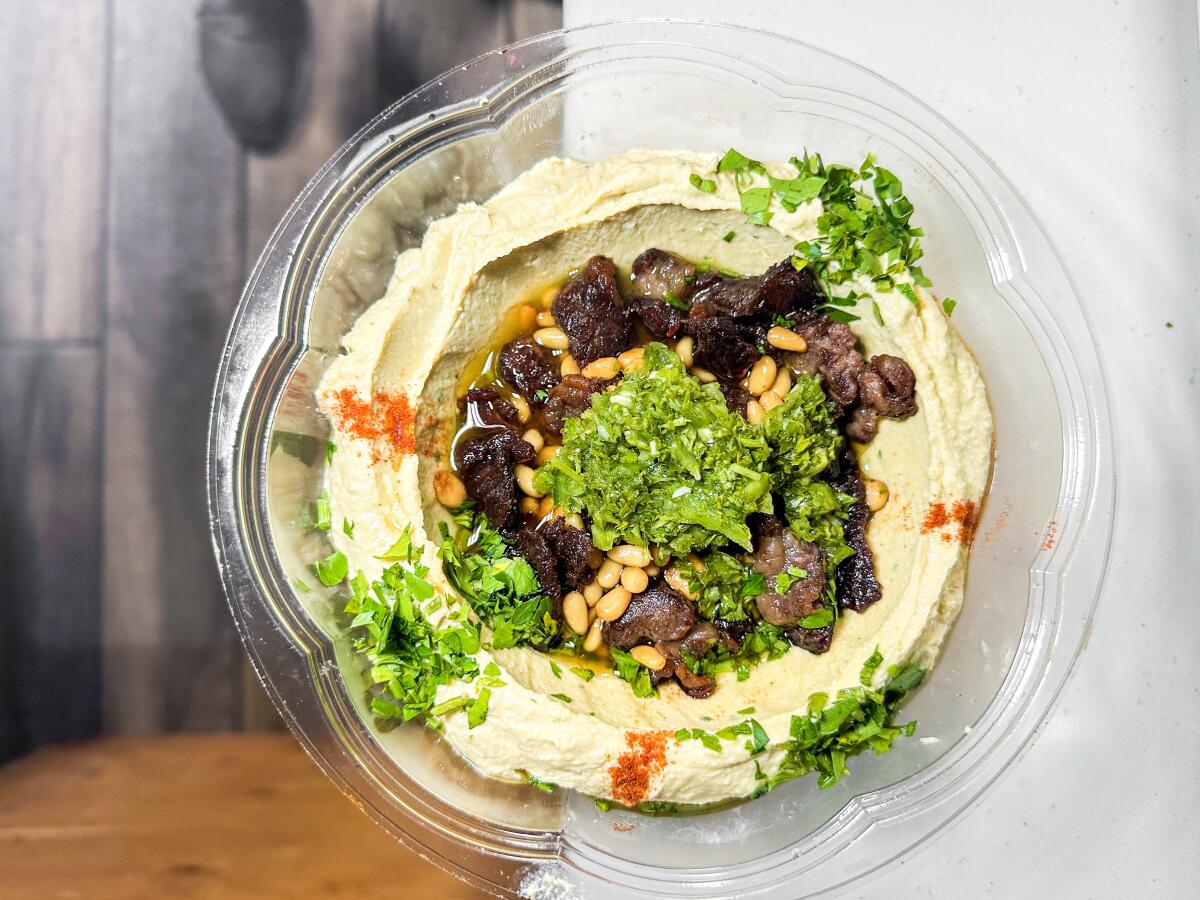A new falafel stand in Koreatown stays open so late it also serves great breakfast

- Share via
Several things have been consistent each time I’ve swung by Salam Falafel, a two-month-old late-night pop-up in a Koreatown strip mall. One constant is that I’m the only customer whenever I show up.
Sohybe Alawneh sits in the back of the space, which operates daily as a location of Baja California Tacos until 8 p.m., waiting to spring into action. I could order ahead on a delivery app but prefer turning up to have a conversation with him. Sometimes Alawneh mentions a dish or two not listed on the online menu.
Falafel made to order in Ktown
On my first visit I stood close to the glass divider between a counter and the kitchen to watch him cook. One by one he scooped balls of falafel batter using a metal scoop designed for the task, rolling each of them gently into a wok filled with boiling oil. It was satisfying to see them bob and darken. Their pocked surfaces kept sizzling for a few seconds when Alawneh pulled them out to drain.
The sight, in its adaptive way, recalled a time in Beirut when I visited twin side-by-side shops, both called Falafel Sahyoun, run by rival brothers who made nearly identical recipes inherited from their father. (One stand has since closed in the wake of the pandemic.) The style of falafel at Salam is similar: smooth and sandy-colored inside, with murmurs of cumin and garlic, and an emphasis on exterior crunch.

Food scholars generally agree that the concept of falafel developed in Egypt, where it’s known as ta’miyah and is commonly made solely with foul (dried fava beans). As the street food spread through the Arab world, ingredients shifted with larders and tastes: Palestinian cooks tend to prefer solely chickpeas in their falafel; the Lebanese often combine garbanzos and foul. In Laila El-Haddad and Maggie Schmitt’s “The Gaza Kitchen” — a beautifully written cookbook and ever more valuable culture document, given the moment’s agonizing realities — the authors detail a recipe that includes nutmeg, cilantro, parsley and a trio of seasonings that summon Gaza’s place on ancient trade routes: dill, garlic and green chile. In her cookbook “Arabiyya,” restaurateur Reem Assil spells out a chile-onion-stuffed falafel I’ve been meaning to try at home.
Some favorites for falafel
Out in the world in Los Angeles, dinner at Saffy’s will always include its lavish shawarma as well as an order of falafel, the innards so stained with herbs that the greenness seeps through the nut-brown crust. More often I seek falafel in its original spirit, as on-the-go sustenance, in whatever form that may take in Southern California.
Falafel Arax is a forever favorite, probably no surprise given my Lebanese affinities: True to the culture, Anto Ohanessian and his Armenian-Lebanese family use both chickpeas and foul in their batter to achieve a quality that’s both fluffy and textured. The garden patio at Kareem’s in Anaheim is such an essential quick stop for the restaurant’s falafel, bright with minced parsley and jalapeño, that we added it to this year’s latest honorees on the 101 Best Restaurants Hall of Fame.

Salam Falafel — which is owned by Bashar Daas, who also owns Salam Lounge a few blocks away — is early in its run and compelling in its promise. Falafel fans should seek this one out for its contrasts and fragrant levels of spice. Right now I’m happiest with a plate of falafel, with sides of tarator (tahini sauce) and shatta, a red-chile hot sauce. A sandwich has all the requisite condiments, including chopped cucumber and tomato and plenty of tarator, but the style of pita Alawneh uses is a little too plush for my taste: It swallows all the fillings and turns a little chewy when he warms the bread in the microwave.
In addition to the typical round falafel, Alawneh might ask if you’d prefer a more oval shape he attributes to Ramallah, the city in the central West Bank six miles north of Jerusalem. The spheres turned out a bit fluffier, but the ovals have more crackly surface geography to savor.
You’re reading Tasting Notes
Our L.A. Times restaurant experts share insights and off-the-cuff takes on where they’re eating right now.
You may occasionally receive promotional content from the Los Angeles Times.
So I make a meal of falafel with an off-menu item Alawneh mentioned off-handedly: hummus bil lahme, a generous bowl of hummus scattered with fried wisps of rib-eye, pine nuts, a green chile version of shatta and the requisite pool of olive oil. The proportions neatly align; I gladly eat it with a spoon (fully knowing it’s classically shoveled with bread).

Salam Falafel stays open until 5 a.m., so he also assembles a couple of traditional Levantine breakfast dishes, including fatteh (pita chips layered with spiced chickpeas, nubbly ground beef and tahini-yogurt sauce) and fudgy, long-simmered foul perfumed with cumin and enriched with olive oil, which also can be mixed with hummus.
I’ve never been much of an out-until-dawn sort of person — how much I’ve missed in life — but recently several of my colleagues amassed a guide to late-night eating, drinking and partying in Koreatown. Among their suggestions for karaoke bars, wallet-friendly steak dinners, Korean pubs and smashburgers, I confidently add Salam Falafel to the mix. Given the hours, most of the time Alawneh takes orders to go from the cordoned-off front door, making it an honest L.A. street-food experience, even if it’s enjoyed inside your car parked in the mini-mall’s spacious, near-empty lot.
223 S. Vermont Ave., Los Angeles, instagram.com/salam_falafel
Have a question?
Also ...
- Danielle Dorsey has a roundup of restaurants recommended by the Food team in April, including (in case you missed it) my review of clubby, welcoming Budonoki in Virgil Village, and three great izakayas the restaurant inspired me to visit.
- Cake person or pie person? Jenn Harris has new recommendations for each in her latest column.
- Meghan McCarron (one of my favorite fellow Eater alums!) pinpoints “a stretch of Venice Boulevard on the border of Culver City and Palms [that] has served as a destination for Brazilian food in Los Angeles.” She names seven stalwarts for Brazilian cuisine in the area and beyond.
- Sarah Mosqueda writes about Sushi Nikkei in Long Beach’s Bixby Knolls neighborhood, where chef Eduardo Chang and his wife and business partner, Daiwa Wong, serve sushi and other dishes that reaffirm that the “connection between Peru and Japan goes back for generations, creating a unique thread in Peruvian life known as Nikkei culture.”
Eat your way across L.A.
Like what you're reading? Sign up to get it in your inbox every week.
You may occasionally receive promotional content from the Los Angeles Times.

Eat your way across L.A.
Get our weekly Tasting Notes newsletter for reviews, news and more.
You may occasionally receive promotional content from the Los Angeles Times.



